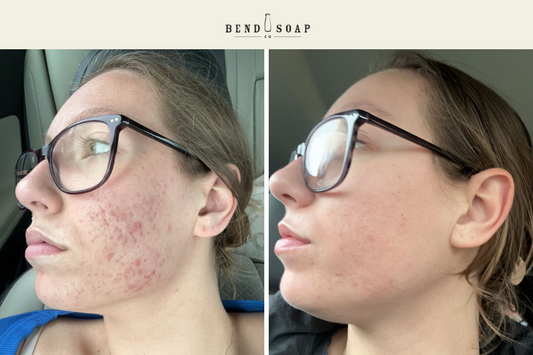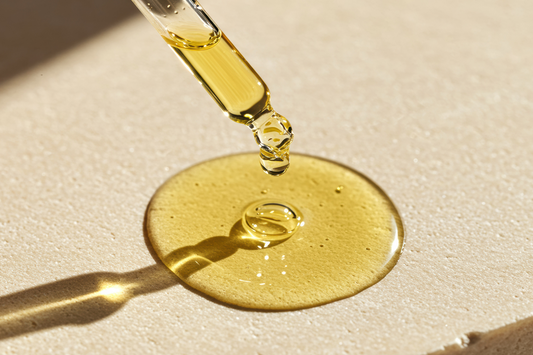Quick Summary
This blog breaks down the truth about conventional bug sprays, including the dangers of DEET and synthetic ingredients. It offers a safe and effective DIY bug spray recipe made with essential oils like citronella, cedarwood, and lemongrass. Perfect for summer, this natural alternative is gentle on sensitive skin, kid-safe, affordable, and smells great. You'll also find bonus prevention tips, answers to common bug spray questions, and everything you need to enjoy the outdoors toxin-free.
You don’t have to choose between itchy bug bites and coating yourself in toxins. Conventional bug spray has never passed the label test—thanks to harsh chemicals like DEET, synthetic fragrances, and preservatives you can’t pronounce. We’ve tried all the crunchy alternatives over the years, and this DIY natural bug spray recipe is our top choice.
It’s simple, smells great, and actually works without exposing your skin (aka your body’s largest organ) to toxins. Today, we’re sharing everything you need to know about making your own bug spray at home. From the problem with store-bought bug spray to why this homemade bug spray is so effective, we’re covering it all.
Ready to take on mosquito season with confidence? Let’s get into it.
Why We Broke Up with Conventional Bug Sprays
Anyone in the crunchy community could tell you that just because something is sold in a drugstore doesn’t mean it’s safe—especially for sensitive skin.
Most bug sprays on the market today are filled with chemicals like DEET that were developed decades ago for military use. And the worst part? Many of them haven’t been tested for long-term effects on developing bodies.
Wait… What is DEET?
DEET (short for N,N-Diethyl-meta-toluamide) is a synthetic chemical developed by the U.S. Army in the 1940s to keep soldiers safe from mosquito bites in jungle warfare. It’s still one of the most common active ingredients in conventional bug sprays because it’s effective at repelling insects, but it comes with a lot of baggage.
Some studies have linked high or prolonged exposure to DEET with skin irritation, neurological effects, and hormone disruption. Add in synthetic fragrances, alcohols that dry out your skin, and other mystery preservatives? It’s no wonder so many people are looking for gentler, natural insect repellents.
Whether you have skin sensitivities or just prefer to be intentional with what you put on your body, there are better options out there. You don’t have to settle for what’s on store shelves.

Natural Bug Spray Benefits – Why It’s Worth It
If you’re internally cringing at the idea of one more DIY item to add to your list, we get it. But hear us out: this homemade bug spray isn’t complicated or messy, and it’s so worth it.
Making your own natural insect repellent means you know exactly what’s going on your skin. No fillers, no endocrine disruptors, and no mystery ingredients. Just simple, skin-friendly oils and water blended into a spray that smells like summer and gets the job done.
This DIY natural bug spray recipe is:
- Kid-safe and gentle on sensitive skin
- Free of toxins, synthetic fragrance, and alcohol
- Budget-friendly (one bottle costs pennies per use!)
- Customizable with your favorite essential oils
- Great for hikes, backyard BBQs, beach trips, and everyday errands
The Best DIY Natural Bug Spray Recipe
This homemade bug spray for your skin is one of the easiest swaps you can make in your journey to non-toxic living. With just a few ingredients, you can create a gentle, effective spray that keeps bugs away and smells way better than anything you’ll find at CVS.
What You’ll Need:
- A 4 oz glass spray bottle
- 3.6 oz distilled water
- ~50 drops of carrier oil (We use almond oil, but jojoba oil works too)
- ~50 drops of essential oils (Our go-to split is 30 drops of citronella, 10 drops of cedarwood, and 10 drops of lemongrass! This has been the most effective blend.)
How to Make It:
- Add the carrier oil and essential oils to your glass spray bottle.
- Fill the rest with distilled water.
- Shake well before each use.
- Store in a cool, dark place for 1-2 months.
Pro tip: Make a few bottles in one batch so you can keep one in your purse, your car, or your diaper bag. You’ll thank yourself later!

Natural Bug Spray Ingredients That Actually Work
Every ingredient in our homemade bug spray recipe is there for a reason—they work! On top of being the best-smelling person at this year’s Fourth of July picnic, the bugs won’t even think about coming near you. Here’s a closer look at why each ingredient works.
- Citronella: This is the queen of natural insect repellents. It’s been shown to repel mosquitoes and other biting bugs almost as effectively as DEET, but without any of the toxic side effects.
- Cedarwood: Has a rich, grounding scent and is known to repel moths, ticks, and mosquitoes. It’s also soothing for the skin!
- Lemongrass: This bright and citrusy essential oil is both uplifting and helpful at repelling mosquitoes and flies.
- Almond oil: Works as a carrier oil to dilute the essential oils and help them stick to your skin while nourishing your skin at the same time.
- Distilled water: Keeps the formula lightweight, non-greasy, and safe for sensitive skin.
More Bug Bite Prevention Tips (The Crunchy Way)
You can spritz on all the natural bug spray you want, but layering in a few extra prevention tricks can make a big difference. Here are some of our favorite ways to stay one step ahead of those pesky insects.
- Cover up: Lightweight, long-sleeved clothes and pants help keep bugs away without overheating you. Mosquitoes love black, so choose light colors if possible.
- Time it right: Avoid going outside at dawn or dusk when mosquitoes are most active.
- Add airflow: Bugs hate wind! Use a fan on your patio or sit near a breezy window.
- Avoid fruity scents: Bugs love sweet-smelling perfumes and lotions. Stick to unscented or essential oil-based products.
- Use natural bug-repelling plants: Citronella, basil, mint, and lavender around your porch or patio help deter unwanted, itch-inducing visitors.
- Nourish your skin barrier: Healthy skin is less reactive to bites. Keep your skin happy with goat milk soap, gentle lotions, and plenty of hydration.
Your Homemade Bug Spray Questions, Answered

What Natural Ingredients Help Repel Bugs?
Essential oils like citronella, lemongrass, cedarwood, tea tree, peppermint, and eucalyptus are all known to repel bugs. These plant-based ingredients confuse and overwhelm a bug’s sense of smell, making them less likely to land on you.
Is Homemade Bug Spray Safe for Babies?
Generally, yes—especially when you use baby-safe oils like citronella and cedarwood in proper dilutions. Always patch test first and avoid spraying directly on the face or hands. Instead, spritz clothing or apply to your legs and arms.
How Long Does DIY Bug Spray Last?
We recommend using your homemade bug spray within 1-2 months, especially if you’re not adding a preservative. Shake well before each use and reapply every 1-2 hours when outside, especially if sweating or swimming.
What is the Best Homemade Spray for Bugs?
This recipe with citronella, cedarwood, and lemongrass is our top pick. It’s balanced, gentle, and truly works. You can tweak the essential oil blend based on what you have, what you like, or what bugs are common in your area.
Is Vinegar and Water a Good Bug Repellent?
Vinegar can help repel some bugs with its strong scent, but it’s not nearly as effective as essential oil-based formulas. Plus, vinegar is acidic and can disrupt your skin’s natural pH, leading to dryness or irritation, especially for those with sensitive skin. It’s better suited for cleaning or surface sprays than for direct use on your body.
Say Goodbye to Bug Bites and Toxins This Summer
You don’t need to douse yourself in toxins to avoid bug bites. This DIY bug spray is proof that a natural bug spray can be simple, effective, and pleasant to use. You can protect both your skin and your peace of mind with just a few natural ingredients.
If you’ve been on the fence about making your own natural insect repellent, consider this your sign to try it out. It’s time to enjoy your summer without the sting of bugs—or toxins. Already have a go-to natural bug spray recipe? Drop it in the comments below!
Want more crunchy living tips? Browse The Sudsy Scoop for DIY recipes, clean swaps, and ways to live happier, healthier, and toxin-free.
Frequently Asked Questions
What natural ingredients help repel bugs?
Essential oils like citronella, lemongrass, cedarwood, peppermint, and eucalyptus work by overwhelming insects’ sense of smell, deterring them from landing on your skin.
Is homemade bug spray safe for babies?
Yes, especially when using gentle oils like citronella and cedarwood at low concentrations. Always patch test first and avoid spraying on the face or hands.
How long does DIY bug spray last?
Homemade bug spray lasts about 1–2 months. Be sure to shake well before each use and reapply every 1–2 hours when outside.
What is the best homemade bug spray formula?
A blend of citronella, cedarwood, and lemongrass diluted in almond oil and distilled water is effective, gentle, and customizable based on scent or bug type.
Can vinegar and water be used as bug repellent?
While vinegar may repel some bugs, it’s less effective and more irritating than essential oil blends. It’s better used for cleaning than skin application.




